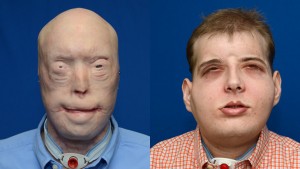
It’s been three months since Patrick Hardison, 41, underwent the most extensive face transplant to date. The swelling is starting to subside, and he is learning how to speak using his new lips, how to eat, and how to swallow.
The volunteer firefighter was injured in 2001 when he entered a burning home on a rescue search. The roof collapsed, leaving him with disfiguring burns across his entire face, head, neck, and upper torso. He lost his eyelids, ears, lips, and most of his nose, as well as his hair, including his eyebrows.
The transplant surgery, which lasted for 26 hours, involved a team of 100 medical professionals, led by Eduardo D. Rodriguez, a professor of reconstructive plastic surgery at NYU Langone Medical Center.
Hardison says he is grateful for the team’s efforts: “They have given me more than a new face. They have given me a new life.”
The surgical team worked in two adjoining operating rooms—in one room the donor’s face was procured (along with other donated organs), and in the other the recipient’s face and scalp burn was removed and the transplant took place.
The donor was David P. Rodebaugh, 26, an Ohio-born Brooklyn artist and bicycling enthusiast, who died from injuries sustained in an accident.

The surgery was pivotal in that the donor’s eyelids and the muscles that control blinking were transplanted—a significant milestone and a procedure that had not been previously performed on a seeing patient.
Hardison endured more than 70 surgeries before meeting with Rodriguez, who previously performed a complex face transplant in 2012.
“When I met Patrick and heard his story, I knew that I had to do all that I could to help him–and every member of my team felt the same way. His surgery sets new standards in facial transplantation and will serve as an amazing learning tool,” says Rodriguez. “I am particularly encouraged with the success we have achieved in transplanting David’s eyelids and blinking mechanisms to Patrick. This is a major milestone–one that could lead to preserving vision in future patients.”

OTHER MILESTONES IN THE SURGERY
- Transplantation of the ears and ear canals
- Transplantation of selective bony structures from the donor, including portions of the chin, cheeks, and the entire nose
- Advanced use of three-dimensional modeling, computerized modeling, and three-dimensional printed patient-specific cutting guides designed from the recipient’s and the donor’s CT scans to provide the most precise “snap-fit” of the skeleton
- Precise placement of patient-specific metal plates and screws to ensure the proper contour and symmetry of the transplanted face
- The transplantation of the donor’s eyelids and blinking mechanisms was particularly important to the surgery’s success, as Hardison was in danger of losing his sight and had been unable to perform independent daily tasks, such as driving. Blinking enables the body to appropriately hydrate and clean the eyes to prevent infection and preserve vision.
EARLY SIGNS OF SUCCESS
Within the final hours of surgery, signs of success were evident. Hardison’s new face, particularly his new lips and ears, were robust with color, indicating circulation had been restored.
The hair on his scalp, as well as the beard on his face, began growing back immediately. He was able to use his new eyelids and blink on the third day of recovery, after the swelling began to diminish. He was sitting up in a chair within a week.
As part of his recovery, Hardison continues to go through extensive rehabilitative therapy. Like all transplant patients, he will need to remain on anti-rejection medication for the rest of his life.
“I am deeply grateful to my donor and his family,” says Hardison. “Even though I did not know who they would be, I prayed for them every day, knowing the difficult decision they would have to make in order to help me. I hope they see in me the goodness of their decision.”
Source: NYU and Futurity.org




